Nicola Willis mini-Budget: Finance minister to reveal ‘fiscal cliffs’ and Government’s economic plans, says Thomas Coughlan
ANALYSIS
The last couple of weeks have been dreadful.
I know you didn’t ask, but there you go - I’ve been dreadful; things have been dreadful.
The reason for my malaise is quite simple: The past fortnight has been the most challenging, and dare I say it, dull, of my professional life.
This had its genesis in the first post-Cabinet press conference of the new Government, when the
new Finance Minister Nicola Willis accused the former Government of only giving time-limited funding to programmes that should really be funded permanently.
In the case of one high-profile example, this would mean Pharmac losing $181 million a year unless the new Government tipped in more money (Labour notes that this was hardly a secret, as it was published in Budget documents and both Labour and National pledged that funding at the election).
But Willis said there were many more programmes funded like this, totalling “many billions of dollars” over the four-year forecast period.
Willis said it had been difficult for Treasury to find all the instances of this type of funding, and she was considering amending the Public Finance Act - the overarching piece of legislation that governs how public accounting works in this country - to force Treasury to publish an easier-to-use list of these kinds of funding in the future.
She added that under the existing system, someone would need to go through the Estimates (Parliamentary patois for “the Budget”) “with a fine-tooth comb” to find them all.
Which brings me to today.
Never one to shy away from a challenge, I’ve have actually done just as Willis suggested. In the past fortnight, I have gone through the Estimates, all 1886 cursed pages of them, not with a fine-tooth comb, but with a spreadsheet, in search of these mythical fiscal cliffs.
Every budget can be divided up into ongoing and new spending.
Now, the “pot” of new spending a government tips into new day-to-day things is called an operating allowance. This pot is so important it’s often mistaken for the budget itself - so intense is the focus on where all that new money goes.
Ongoing spending is, well, ongoing. It’s pay for teachers, superannuation, money for running hospitals, money to keep the lights on (literally in some cases). No one cares about it - that is until inflation has eroded the value of that ongoing spending to the point where people notice the quality of their services has eroded too.
Every year, when a budget is presented, most spending lines are more or less copied and pasted from the prior year.
In most cases, however, a Government will need to top up that year’s funding with money because each year it gets a bit more expensive to fund the same services than the last year. These top ups usually (but don’t always) come from the operating allowance (things like superannuation and other benefits go up automatically depending on need).
If the Government wants to fund something new, like the decision this year to remove the $5 co-payment from prescriptions, this has to come from that allowance too.
Like an allowance a parent doles out to a child, these allowances are constrained. We expect our politicians to make prudent trade offs. This means setting realistic allowances that don’t bake-in unrealistic amounts of new spending, and making sure that existing service levels are properly funded before embarking upon silly and unrealistic fiscal adventures.
What Willis is alleging with her “fiscal cliffs” is that a whole lot of Government programmes that we think are permanent, are in fact only funded for a limited time. The Government has done this to make its books look better, because programmes all of a sudden vanish from its spending forecasts.
This is no small amount of spending. The most well-known “cliffs”, Pharmac spending, the apprenticeship boost scheme, and school lunches, require $1.7b over the next four years to sustain themselves (and that only includes three years of lunches).
But because both Labour and National have pledged to fund these lines, it means that this money is simply sitting in a different “pot”. The funding is not sitting in a department’s ongoing funding line, instead it’s sitting in the operating allowance, ready to be carried across. It’s not an orthodox way of going about things, but there is no net effect on the books.
What did I find?
The “fiscal cliff” label is an invention of the National Party. Finding a definition that works for the dry and arcane world of the real black and white and red Estimates (they change between red and blue depending on who is in government - tragic, but not quite as tragic as the bust up over Treasury deciding to turn its “neutral” EFU documents an allegedly National-leaning shade of cerulean) is more difficult than you might think.
While some lines are fairly obvious, others are more difficult.
Governments of both stripes have made use of what are called multi-year appropriations. These give the Crown the authority to spend a certain amount of money over many years. These appropriations wrap up when the money is exhausted or the spending period ends.
Some of these are fairly significant. There’s $391.9m for the Screen Production Grant, a budget line originating in 2021, of which $102.1m remains.
The grant is our main film subsidy, offering international filmmakers 20 or 25 cents back on every dollar they spend here.
Despite a recent review finding the production sector was keen to establish some certainty in the ongoing viability of the scheme, it’s appropriated on a temporary basis.
When the appropriation runs out at the end of the 2025 Budget, the Government will need to decide whether to appropriate more money to keep the scheme alive, or to let it expire (Prime Minister Christopher Luxon indicated he was keen to renew the funding, although his coalition partner Act has previously called for the scheme to be axed).
The curious funding of that particular budget line can’t be pinned on Labour either. The current regime was designed under the former National Government. Its last budget only funded the scheme through to 2021.
How many, if any?
In all, I found exactly 190 lines of the 2023 Budget relating to lines of expenditure that end before the four-year forecast period is up. I’ve excluded capital spending (obviously - who needs to build a hospital twice?) and things related to the cyclone recovery.
My tally is there is $1.7 billion in spending on time-limited initiatives this year, $1b next year, and $297,500 the year after that - about 1.4 per cent of total spending.
It’s not all from the most recent budget, some is carried over from prior years, and a lot will be fairly contentious. Because there isn’t a good definition of what a “cliff” is, it’s hard to come up with a comprehensive list.
Some of this stuff is fairly mundane.
For example, $2.5m will be spent in the next year addressing “cost pressures for teacher supply” initiatives like scholarships; an extra $1.6m will be spent on administering the 20 hours free early childhood education policy; about $1.6m will be spent over the next three years on policy advice for how to make the zero emissions transition more equitable, and about $350,000 over the next two years will be spent on “stewardship” of the alternative education sector.
A fiscal cliff? Looks a bit like one to me.
There are a whole number of things funded like this: $112m for R&D grants between now and 2028; $130m between 2020 and 2024 for NZ Post to transition itself so that it can sustain a “minimum level of mail service”; and $24.6m for the FIFA Women’s World Cup.
Here you see the complexity of the “fiscal cliffs” debate. In the case of the film subsidies, if the Government is promising certainty and trying to establish a permanent industry here, the grants should probably be funded permanently, while in the case of NZ Post, once the organisation has transitioned to a sustainable operating model, it makes no sense for that $130m to be continued, and in the case of the FIFA Women’s World Cup, well, we only need to spend that money when we’re actually hosting FIFA - we don’t need it every year.
For the likes of R&D incentives the case is more complicated. We might want these to be permanent, but it perhaps makes better fiscal sense for the Government to set aside funding for them, and make a call on extending the scheme when that funding runs out.
Others seem to have a good explanation. Some (but not all) funding for cameras on the fishing fleet runs out in 2025, although a press release from the 2022 Budget explains that cost recovery from the sector will pick up the slack (the funding is worth $12m in its final year). That’s the
same for the funding used for the Three Waters economic regulator, which would have been funded by charges on the Three Waters entities.
So you see the scale of the challenge - sometimes a fiscal cliff is obvious, but sometimes it’s in the eye of the beholder.
The Government’s implementation unit was given two more years of funding ($1.9m a year). When it was established in 2021, the Government only gave the unit two years of funding, taking it to June 30, 2023. The new funding gives it a few more years.
You might have a grumble about some of this stuff, but the sums are so small in the context of the Budget, it’s impossible to argue they’re fiscal chicanery on a grand scale.
Some budget lines are more curious. The Government is spending $15.9m on the “clean car upgrade” scheme (better known as cash-for-clunkers) until the middle of next year. The scheme would allow low-income people subsidies to scrap their vehicles and get a low-emissions car. This is despite the scheme being scrapped in Chris Hipkins’ policy bonfire prior to the Budget, saving $568m.
Unsurprisingly, the biggest items are the ones Treasury has already sounded the alarm over - the likes of the school lunch programme. But we knew about these, and so did National - it’s impossible to argue they were hidden, though it is worth discussing whether we should fund semi-permanent initiatives like this permanently (a discussion no one wants to have because it would probably require talking about levels of taxation...)
There are a few other biggies. Funding for “retaining and recruiting bus drivers”, equating to a little over $30m a year, ends in three years; about $20m a year to improve “teaching and learning” as part of the NCEA change programme also runs for just three years, and about $55m to sustain the Defence Force’s ailing frigates also expires in three years.
These funding pose big problems. What happens when the funding to retain bus drivers runs out - do they just leave?
There’s a similar problem in the Social Development budget, where the Government spent $65m this year on additional frontline staff and “service delivery cost pressures”. This runs for three years, but ends at the fourth year, with no indication of what might occur should those cost pressures not dissipate in the fourth year.
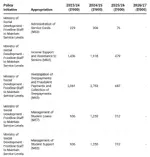
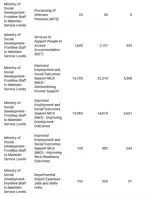
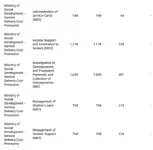
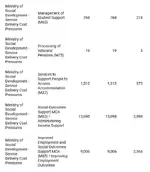
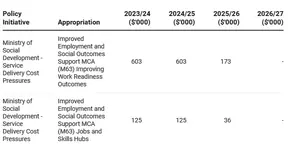
Other funding lines from previous budgets are also time-limited. The
Government’s $34m boost to the beloved Te Matatini kapa haka festival expires after two years, as does the $8m a year set aside for free period products in schools.
They’re both “cliffs” in the sense that a lot of people would probably think the schemes deserve permanent funding - but there’s certainly no conspiracy on the part of the Government. The fact the funding was temporary was mentioned in the press releases announcing both schemes.
A culture of misappropriations?
Part of the issue here appears to be a bit of fiscal long Covid. Both the school lunches programme and the apprenticeship boost scheme, together requiring more than $1b over the next four years, began life as temporary Covid measures, funded with the Covid-19 Response and Recovery Fund.
With that fund now closed, ministers face the choice of ongoing, temporary top-ups, permanent funding, or closing the schemes entirely.
There are lines, however, that look like a knee-jerk reaction to problems the Government hopes will go away. There’s $7m over the next two years to “turnaround” school attendance. The thinking, one supposes, is that by the time this funding dries up in June 2025, school attendance will indeed have been turned around, but what if it isn’t?
A line of $8m for the Fog Cannon subsidy scheme for retailers also runs out in 2025, although the Government has been fairly clear this fund was time-limited.
What does Labour say?
Labour’s counter-allegation to National is that Willis is running a scare campaign about fiscal cliffs to hide the fact that National will need to back track on parts of its own fiscal plan. Former Finance Minister Grant Robertson pointed out that National has described its unallocated operating spending as a “buffer” to pay for anything unexpected.
His argument is National can’t describe this allowance as a
“buffer” because the plan did not include upwards adjustments in the day-to-day spending levels of departments (with the exception of Health). This is normal, Labour’s plan was calculated this way too, but in Labour’s plan the unallocated money was not be described as a “buffer” but as money set aside to pay for the ever increasing cost of services in future budgets.
In a rather delicious twist of irony, this is an upside-down version O.G. fiscal hole argument of 2017, when funding that National though should have been sitting in the unallocated operating line was found pre-allocated in other lines.
The Labour argument is that that money can’t be both money for sustaining public services at the same time as it is a buffer - you only get to spend it once.
A Christmas present for... me
The biggest challenge in putting this list together is that none of these budget lines are easily found in one place.
Willis says she wants to change this, requiring Treasury to publish a list of “fiscal cliffs”, making a list like this far easier to compile in the future.
The Estimates are never going to be an easy read, but they don’t need to be as complicated and diffuse as they are now, and more disclosure is never a bad thing.
If nothing else, it’ll be a Christmas present to me. I fear the next fiscal cliff I’m forced to find will be one I throw myself from.
Thomas Coughlan is Deputy Political Editor and covers politics from Parliament. He has worked for the Herald since 2021 and has worked in the press gallery since 2018.
I spent the last fortnight reading 2000 pages of Budget documents.

www.nzherald.co.nz





